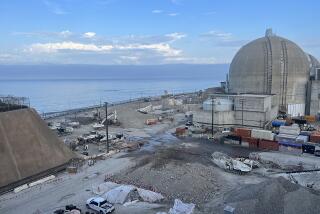Disaster at Chernobyl No ‘Surprise’ : SDSU Geographer Is Top U.S. Expert on Soviet Conservation
SAN DIEGO — As a cloud of radioactivity from the damaged Soviet nuclear power plant at Chernobyl drifted across Western Europe recently, Phil Pryde’s telephone in San Diego began ringing off the hook. Members of the American news media needed information about the construction and safety of nuclear reactors in the Soviet Union, and one of the first people they turned to was Pryde, a professor of geography at San Diego State University.
Pryde, 48, has visited the Soviet Union four times, most recently in 1983 as part of an exchange program between American and Soviet scientists. He is the top U.S. expert on conservation and environmental protection within the Soviet Union and has followed closely that country’s growing commitment to nuclear power.
The accident at Chernobyl “really didn’t surprise me too much,” Pryde said. The Soviets place great importance on meeting the production goals of their five-year plans, he said, and when the end of a year looms, they tend to give construction deadlines for new industrial facilities priority over any plans or equipment that might prevent environmental catastrophes. Under such pressure, the chances for an accident rise significantly.
“I would say that probably half of all their nuclear power plants have begun operating in the month of December--and probably in the last week of December--so the managers could say they had met the deadline of a particular plan,” Pryde said.
“If you fulfill the goals of your plan, you might get a week’s vacation on the Crimea,” he said. But no one gets a week on the Crimea for building a sewage treatment plant or completing an evacuation plan for a nuclear reactor accident, he pointed out.
The Soviet drive to rapidly increase industrial output has also led to other environmental problems--problems that for the most part are similar to those in the United States. Pryde said that, in addition to the inherent hazards of nuclear technology and its resulting wastes, the Soviets are trying to deal with air and water pollution, endangered animals and plants, and dwindling reserves of domestic oil.
“Certainly the scientific community in the Soviet Union understands the problems and the need for environmental protection,” he said. “As in the U.S., it’s a matter of (constantly) playing catch-up. . . . and they’re strapped for funds.”
But there are important differences between the two countries’ approaches to conservation, too. According to Pryde, the differences are sharpest in environmental legislation and public activism.
Pryde first visited the Soviet Union for several months as a graduate student in 1967. His doctoral dissertation was entitled “Conservation in the Soviet Union,” and the subject has been the main focus of his research ever since.
He became interested in the Soviet Union after learning about it while serving in U.S. Army intelligence. In graduate school, he decided to specialize in resource conservation, a branch of geography that focuses on the use of land, energy and water resources.
Pryde speaks some Russian, is proficient at reading it, and keeps up with environmental issues within the Soviet Union by reading newspapers such as Pravda and Izvestia, as well as Soviet textbooks and scientific journals. He has also visited many education institutions in the Soviet Union and has talked with their environmental experts.
He returned to the Soviet Union in 1976 to attend a geographers’ conference, and again in 1978 to study Soviet environmental law and public education programs on environmental issues. In 1983, he visited the country again with other American geographers. “I’ve been in most parts of the country at one time or another,” he said.
On the 1983 trip Pryde toured a pulp mill, an aluminum processing plant and the Chernozem nature preserve near the city of Kursk.
“Their preserves are not quite what we would call national parks,” he said. “They’re more like wildlife refuges, but . . . they don’t have public recreation as a main function, so they don’t have to have a lot of fancy visitor facilities. The preserves--and there are more than 130 of them--are considered to be scientific research stations.”
Many of the preserves have been established to protect endangered species. According to Pryde, Soviet scientists have identified 70 endangered species in their country, including 21 mammals and 23 birds.
However, when concerns for endangered species conflict with economic development, development usually prevails. The Soviet Union lacks stringent legislation like this country’s Endangered Species Act, which requires mitigation for any development that will affect important habitat. “There are laws that set up guidelines for development, but are they always carried out? I suspect the answer is no,” said Pryde.
“They can point to many successes--they’ve reestablished native bison, which had been virtually eliminated. But preservation usually boils down to how much it costs. I’m not aware of any conservation effort in the Soviet Union comparable to the effort on the California condor, for example, where millions of dollars are being spent on one species.”
On the other hand, air pollution standards in the Soviet Union are stricter than those in the United States--although they are not always met. And Pryde said the Soviet government is promoting the recycling of paper and industrial materials.
Like the United States, the Soviet Union must also cope with dwindling reserves of domestic oil. Unlike the United States, however, the Soviet Union is solving this problem with “a very aggressive nuclear power plant program.”
“That’s a major priority,” said Pryde, noting that the Soviet Union has 40 to 50 commercial nuclear reactors operating, and 10 to 12 more under construction. At least four of these are being built in urban areas.
In comparison, the United States has 101 licensed commercial reactors and 29 under construction. But Pryde pointed out that no new commercial nuclear reactors have been ordered in the United States since 1980, whereas the Soviets are planning new nuclear power plants almost yearly.
Pryde said that, in contrast with the United States, there are no unfettered newspapers and few individuals in the Soviet Union who challenge government’s environmental policies, such as the decision to greatly expand nuclear power.
“There’s a much smaller core of environmental activists in the Soviet Union that have a strong personal commitment to the environment, and who would stick their necks out a bit to oppose (pollution). Letters to the editor appear in the press all the time, but how much good does a letter to the editor do?” Pryde said. “You can’t send a petition with 10,000 signatures on it to your congressman. . . . In the United States, some politicians seem to experience an environmental rebirth as an election approaches. That is not something that would occur in the Soviet Union.”
Although he has no specific plans to do so, Pryde said he hopes to visit the Soviet Union again in the future. He is concerned, though, that the accident at Chernobyl will exacerbate a trend over the last five years for Soviet officials to be increasingly defensive about their system of government and such things as their country’s record of environmental protection.
“The Soviets don’t take criticism very well. They tend to think (any criticism) is anti-Soviet propaganda,” he said. “Chernobyl is certainly not going to help.
“But pollution is not a matter of ideology--any industrial country is going to have it. You can’t avoid industrial pollution just because you build your plants under socialism or capitalism. The economic system is not as important as the attitudes and will power of the people involved.
“Nuclear power, like any other industry, has an inherent lack of safety in it, and a nuclear power plant is only as safe as you make it with technology and the training of personnel. Until two weeks ago, the Soviets thought their technology was very safe. I guess they’re rethinking that now.”
More to Read
Sign up for Essential California
The most important California stories and recommendations in your inbox every morning.
You may occasionally receive promotional content from the Los Angeles Times.










